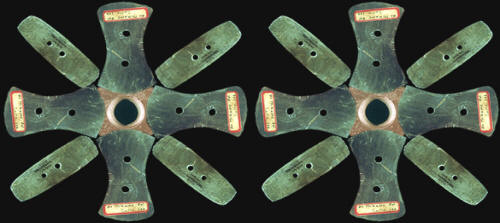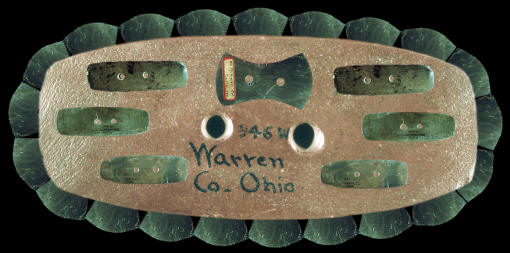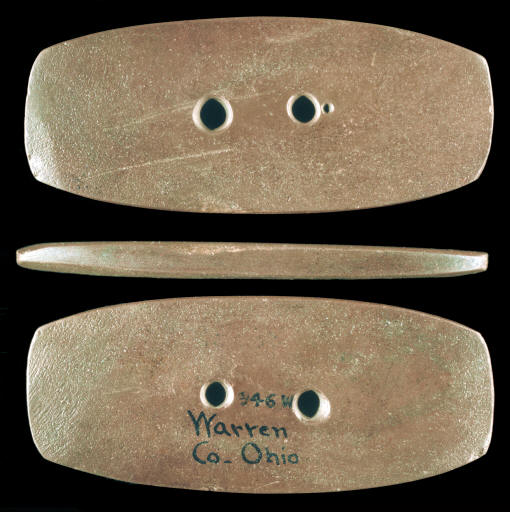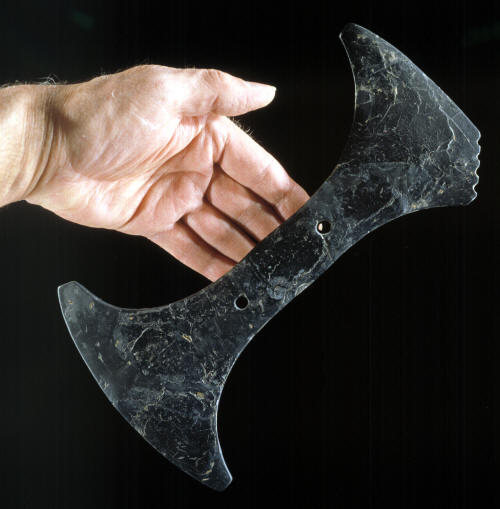|
||
|
||
|
"The term (gorget) applied to objects worn in some proximate relation with the gorge (throat) or throat. They may be suspended by a string or chain encircling the neck, or may be attached to the dress"----1912, by Frederick Webb Hodge, "Handbook of American Indians North of Mexico, part 1, p. 496. "(Gorgets)---may be simple ornaments not differing materially in form or significance from those used to embellish the ears, hair, wrists, or they may have special significance as symbols, insignia, charms, etc."----1912, by Frederick Webb Hodge, "Handbook of American Indians North of Mexico, part 1, p. 496. "Gorgets or "pierced tablets" constitute another class of polished "slates" of the problematical class, of considerable interest to the archaeologist."----1917, by Warren K. Moorehead, "Gorgets," Stone Ornaments Used By Indians In The United States And Canada, pp. 204-225. "The difference between the gorget and pendant seems only to have been in the number and position of the holes,"----1896, by Thomas Wilson, "Prehistoric Art; of The Origin of Art As Manifested In The Works Of Prehistoric Man," Report Of The U.S. National Museum, p. 452. "Most of them (gorgets) are made of slate, thin, not difficult to make, nor yet particularly beautiful when made"----1896, by Thomas Wilson, "Prehistoric Art; of The Origin of Art As Manifested In The Works Of Prehistoric Man," Report Of The U.S. National Museum, p. 452.
In archaeology, the term gorget has been used to describe a wide range of different types of cut, ground and polished objects that were drilled with two or more holes. In the dictionary gorgets are defined as armor used to protect the throat or neck. But prehistorically, the artifacts that have been labeled as gorgets, were apparently used for several different purposes. That's why some authors have referred to them as "problematical objects." Warren K. Moorhead comments that "Perhaps it is the unknowable element about these smoothly polished, perforated tablets of soft-toned slate that lends charm to them." |
||
|
Slate gorgets have often been reported from burials. But, Webb and Snow (1945) writes that "There seems to have been little or nothing observed in their actual occurrence in burial associations to justify the term gorget." They point out that some gorgets were found with burials in the region of the hips or lower extremities. They suggest that some of them could have been used as atlatl weights. They describe one burial that contained a well worked antler handle that was found in alignment with the stone gorget at the proper distance that suggested they were both part of an atlatl. But they also report that reel-shaped gorgets were found in positions around the necks of other individuals. In another source, Moorehead (1892) describes a burial where "On the head of the second skeleton was a fine slate gorget." |
||
|
So it appears, that stone gorgets might have been used for several different purposes. Some of them may have been worn as ornaments, with no more significance than any other form of jewelry. Or they may have been objects of importance that were representations of tribal symbols or insignia. They may also have been charms or talisman that contained a certain degree of supernatural power. According to Webb and Snow, some of them may have even been used as atlatl weights. |
||
|
Many years ago, there were even more suggestions about how gorgets might have been used. Some were thought to have been used as "sinew or thong smoothers" because the holes could have been used to draw the sinew through. They have been described by some authors to be shuttles for weaving or sizers or gauges for net making. Another suggested use for gorgets has been for making rope, as two cords could have been passed through the holes and spun together. But no one today is seriously suggesting any of these theories. |
||
| CONTINUE ON TO PAGE TWO | ||
|
"REFERENCES"
1892, Moorehead, Warren K.,
"Primitive Man In Ohio," p. 157. |
||





